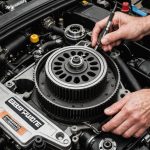Airbags have become an integral part of vehicle safety. They stand between you and severe injury in the event of a crash. Their name may sound innocuous, but their function is anything but. In those critical fractions of a second during a collision, an airbag can mean the difference between life and death. But how can you ensure the airbags in your vehicle are properly functioning? How can you be sure that, when needed, they will deploy correctly and provide the protection you need? We detail the steps below.
Understand how the airbag system works.
Before diving into the steps, it’s crucial to understand how your car’s airbag system operates. The airbag system in your vehicle is complex. It includes multiple airbags, sensors, a control unit, and an inflator.
Topic to read : What are the key safety factors to consider when using roof racks on long-distance trips?
Airbags are made of light, thin materials and filled with a gas (often nitrogen or argon) that allows them to inflate quickly during a crash. They are located in various parts of your vehicle, such as the steering wheel, dashboard, doors, roof, and even the seats themselves.
When a crash happens, sensors detect the sudden deceleration and send a signal to the control unit. If the crash is severe enough, the control unit triggers the inflator to fill the airbags with gas. This all happens within milliseconds.
Additional reading : How does the adjustment of rear-view mirrors differ in a convertible compared to a sedan?
Regularly check the airbag warning light.
The first step in ensuring your airbags are functioning correctly is to regularly check the airbag warning light on your vehicle’s dashboard. This light is part of your car’s internal diagnostic system and serves as an early warning sign if there are issues with the airbag system.
When you start your car, the airbag warning light should illuminate briefly and then turn off. If the light stays on, or if it comes on while you’re driving, there may be a problem with your airbags. It could mean the airbags won’t deploy in an accident, or worse, they could deploy unexpectedly. If the airbag warning light comes on, you should have your vehicle inspected by a professional as soon as possible.
Regularly inspect the airbag covers.
The next step is to inspect the airbag covers. The covers for your vehicle’s airbags are typically located in your steering wheel, dashboard, doors, and seats. If these covers are damaged or warped, it could hinder the proper deployment of the airbags.
Look for signs of wear, tear, or warping on these covers. If you notice any damage, you should have your vehicle inspected by a professional. A damaged cover might not solely indicate a problem with the airbag itself, but it could give a clue about potential issues within the system.
Get professional inspections.
Professional inspections are a crucial part of ensuring your airbags are functioning correctly. While regular checks of the warning light and covers can identify obvious issues, a professional inspection can uncover more subtle problems that might not be immediately apparent.
A professional will have the tools and knowledge to thoroughly inspect your car’s airbag system. They can check the condition of your airbags, ensure the sensors are working correctly, and make sure the control unit is functioning as it should. They can also inspect the wiring and connectors, which are vital for the proper operation of the airbag system.
Replace airbags after an accident.
Finally, if your vehicle has been in an accident and your airbags have deployed, they need to be replaced. Once an airbag has been deployed, it can’t be reused. Even if it appears to be okay, the components inside the airbag system may have been damaged or compromised during deployment, and it might not function correctly in another crash.
It’s important to mention that only a professional should replace your vehicle’s airbags. Improper installation can cause the airbags not to deploy correctly, or they could deploy unexpectedly, which could lead to severe injury or even death.
So, to ensure the airbags in your vehicle are functioning correctly, you should understand how they work, regularly check the airbag warning light, inspect the airbag covers, get professional inspections and replace airbags after a crash. Following these steps can help ensure your airbags will function correctly when you need them most.
Understand Your Vehicle’s Airbag Features
Understanding the specific features of the airbag system in your vehicle can further help ensure they are working correctly. Different vehicle models have varying features in their airbag systems, so it is important to familiarize yourself with the specifications of your own.
Most vehicles are equipped with frontal airbags, which are designed to inflate in moderate to severe front crashes. These airbags are located in the steering wheel and the dashboard on the passenger side. Some vehicles may also have side airbags. Side airbags improve protection in side crashes by inflating between the occupant and the door. They’re often found in the seat or door and can protect your torso and, in some vehicles, your head.
Newer models may also have a knee airbag that deploys from the dashboard beneath the steering wheel. These are designed to distribute the impact forces during a crash more evenly across the body, reducing the likelihood of serious injury.
Vehicles may also be equipped with a seat belt pre-tensioner system. This works in conjunction with the airbags to retract the seat belts at the moment of impact, securing occupants in the optimal position for airbag deployment.
Finally, the airbag control unit is the system’s brain. It can calculate the severity of a collision and determine which airbags to deploy and when.
Understanding these features enables you to make informed decisions when maintaining or repairing your airbag system, enhancing your car safety.
Maintain Proper Seating Position
Maintaining a proper seating position is another critical factor in ensuring the effective operation of your airbags. Improper seating position can decrease the effectiveness of the airbags and even result in injuries from an airbag deployment.
The driver and front-seat passenger should sit as far back as possible from the steering wheel or dashboard while still being able to comfortably reach the pedals or glove box. For the driver, the steering wheel should be tilted toward the chest, not the face or stomach, to allow the airbag to cushion the chest during a frontal crash.
Remember, airbags deploy at high speeds, usually around 100 to 220 miles per hour. Sitting too close to the steering wheel or dashboard can put you in the path of a deploying airbag.
For the best protection, everyone in the car should wear their seat belts. The seat belt and airbag work together to provide the best protection in a crash. The seat belt keeps you in place, while the airbag cushions the impact.
Conclusion
Airbags are an essential safety feature in every vehicle. They can significantly reduce the severity of injuries sustained during an accident. However, for airbags to function optimally, they need to be maintained and handled correctly. Understand how your car’s airbag system works, regularly check the airbag warning light and airbag covers, and get professional inspections. Also, remember to replace airbags after a crash.
Furthermore, familiarize yourself with your vehicle’s specific airbag features such as frontal airbags, side airbags, knee airbags, seat belt pre-tensioner system, and the airbag control unit. This understanding will help you make informed decisions regarding your vehicle’s safety features.
Finally, maintain proper seating positions and always use your seat belts. These habits will ensure that you get the maximum protection from your airbags in the event of a collision. Regular checks and maintenance combined with proper usage can help ensure that your airbags will work as expected when they are needed most. Your safety while driving is paramount, and taking these steps to ensure the correct functioning of your airbags is fundamental to achieving it.











